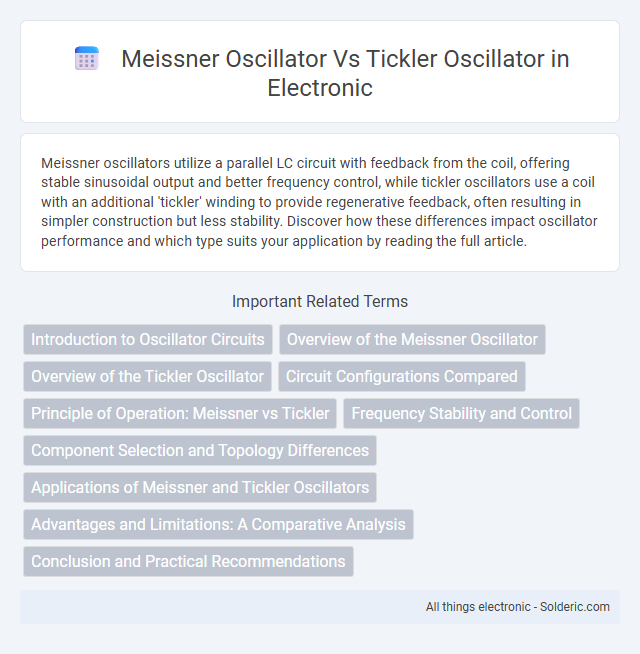Meissner oscillators utilize a parallel LC circuit with feedback from the coil, offering stable sinusoidal output and better frequency control, while tickler oscillators use a coil with an additional 'tickler' winding to provide regenerative feedback, often resulting in simpler construction but less stability. Discover how these differences impact oscillator performance and which type suits your application by reading the full article.
Comparison Table
| Feature | Meissner Oscillator | Tickler Oscillator |
|---|---|---|
| Oscillator Type | LC Oscillator with inductive feedback | LC Oscillator with tickler coil feedback |
| Feedback Method | Feedback through coil inductively coupled to tank circuit | Feedback via tickler coil inductively coupled to transistor/base circuit |
| Tank Circuit | Consists of inductor and capacitor | Also an LC circuit, with an additional tickler coil |
| Common Usage | High-frequency oscillator, RF generation | Low to medium frequency oscillator, audio and RF applications |
| Construction Complexity | Moderate, simpler coil configuration | More complex due to additional tickler coil |
| Stability | Generally stable with proper tuning | Stability depends on coil coupling and placement |
| Example Applications | Radio transmitters, signal generators | Oscillators in audio circuits, RF amplifiers |
Introduction to Oscillator Circuits
Meissner oscillator and tickler oscillator are both types of LC oscillators that generate continuous sinusoidal signals by using inductors and capacitors in their feedback networks. The Meissner oscillator employs inductive coupling through a tapped coil or a separate feedback coil, while the tickler oscillator uses a feedback coil called the "tickler" coil wound on the same core as the tank coil to provide regenerative feedback. Both circuits rely on positive feedback and resonance in the LC tank circuit to sustain oscillations, but their feedback coil configurations differentiate their design and performance characteristics.
Overview of the Meissner Oscillator
The Meissner oscillator is a type of LC oscillator that uses inductive coupling through a tapped coil to provide the necessary feedback for sustained oscillations, distinguishing it from the tickler oscillator which employs a separate feedback coil. This design enables the Meissner oscillator to generate stable sinusoidal waveforms at radio frequencies efficiently. Your choice between the two depends on circuit simplicity and the specific feedback configuration required for your application.
Overview of the Tickler Oscillator
The Tickler oscillator is a type of feedback oscillator that uses a coil known as the tickler coil to provide positive feedback, maintaining sustained oscillations. Unlike the Meissner oscillator, which relies on a tapped coil for feedback, the Tickler oscillator employs a separate coil magnetically coupled to the tank circuit. This configuration allows for easier adjustment of feedback and frequency stability in radio frequency applications.
Circuit Configurations Compared
Meissner oscillators use a tapped coil as an inductor and feedback element, where the feedback is taken from a coil tapped point, creating inductive coupling within a single coil. Tickler oscillators feature a separate feedback coil (tickler coil) that is magnetically coupled to the main tank circuit coil, enabling adjustable feedback strength. The Meissner circuit integrates feedback into one coil winding, while the Tickler circuit relies on two inductively coupled coils for oscillation control.
Principle of Operation: Meissner vs Tickler
The Meissner oscillator operates on the principle of inductive feedback using a tapped coil where a portion of the coil provides the necessary feedback to sustain oscillations. In contrast, the Tickler oscillator employs a separate feedback coil, called the tickler coil, magnetically coupled to the main coil, which induces feedback voltage to maintain oscillations. Both designs rely on positive feedback through inductive coupling, but Meissner integrates feedback within the coil, while Tickler uses an additional coil for feedback.
Frequency Stability and Control
Meissner oscillators exhibit moderate frequency stability due to their LC tank circuit design, which makes them sensitive to component tolerances and temperature variations. Tickler oscillators improve frequency control and stability by incorporating a feedback coil (tickler coil) that enhances the regenerative feedback mechanism, reducing phase noise and frequency drift. Overall, tickler oscillators offer more precise frequency adjustment compared to Meissner oscillators, making them preferable for applications requiring stable oscillation frequencies.
Component Selection and Topology Differences
Meissner oscillators utilize a common-base or common-collector transistor configuration with the feedback provided by a tapped coil, emphasizing a simpler topology and easy frequency adjustment through coil taps. Tickler oscillators, on the other hand, employ a feedback coil (tickler coil) inductively coupled to the main tank circuit, requiring careful component selection for optimal coupling and stability. Your choice between these oscillators depends on the desired frequency stability and ease of tuning, as Meissner designs favor straightforward component arrangement while tickler designs allow more precise feedback control.
Applications of Meissner and Tickler Oscillators
Meissner and Tickler oscillators are widely used in radio frequency (RF) signal generation and wireless communication systems due to their stable frequency output and simplicity. Meissner oscillators are commonly applied in RF transmitters, local oscillators in receivers, and signal modulators, where frequency stability is essential. Tickler oscillators are favored in low-frequency and audio frequency applications, serving as signal generators in testing equipment and frequency modulation circuits, allowing you to achieve precise signal control.
Advantages and Limitations: A Comparative Analysis
Meissner oscillators offer advantages such as simpler design and greater frequency stability due to their use of inductive feedback via a single coil, making them ideal for high-frequency applications. Tickler oscillators provide stronger feedback and easier tuning through an additional feedback coil, but this can introduce increased noise and less stability under varying conditions. Your choice between these oscillators depends on whether stability or feedback strength is more critical for your specific electronic circuit needs.
Conclusion and Practical Recommendations
Meissner oscillators offer simplicity and stable frequency generation, making them ideal for beginners and applications requiring consistent oscillation. Tickler oscillators provide enhanced feedback control and higher signal amplitude, suitable for advanced users needing precise frequency tuning in radio frequency circuits. Your choice should depend on the required stability, complexity, and application environment to achieve optimal oscillator performance.
meissner oscillator vs tickler oscillator Infographic

 solderic.com
solderic.com